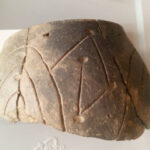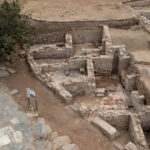This new image from the High Resolution Stereo Camera (HRSC) aboard ESA’s Mars Express orbiter shows a diverse region southeast of the Pickering crater in Terra Sirenum, a complex cratered region in the southern hemisphere of Mars.
This image, taken by Mars Express’ High Resolution Stereo Camera (HRSC) on April 5, 2022, shows the Terra Sirenum region on Mars. Image credit: ESA / DLR / FU Berlin / CC BY-SA 3.0 IGO.
Terra Sirenum is a vast highland region over 3.5 billion years old in the southwest of the Tharsis volcanic region.
Here, and in the southern highlands in general, there are more impact craters on the surface than in the northern lowlands.
“The HRSC image is dominated by a large impact crater about 70 km (43.5 miles) wide,” said members of the Mars Express team.
“The imprint of Martian winds is detectable within the crater — in its lower, eastern part, rough features known as yardangs are visible signatures of wind erosion.”
“The contrasting dark-toned sand within the crater may have been transported into the flat base by wind.”
“Nestled within the large crater is a smaller crater measuring about 20 km (12.4 miles) wide,” they added.
“The structure and outline of the crater, and its smaller neighbor, suggest that water or ice may have covered this surface when the impact occurred.”
“Water also leaves its mark in other parts of the scene. The winding valley on the far left of the main color image measures up to 1.8 km (1.1 miles) in width. It is thought to have been a pathway for water which melted in the basin to the east.”
“The north side of the image showcases a complex region of twisting valleys, known as dendritic valleys, whose origins are believed to be due to rain or snow early in Martian history.”
The surface of Mars is marked by the results of tectonic stress on the planet’s crust.
“Parallel to the large valley, and about 10 km (6.2 miles) away, lies a fracture which cuts through the basin,” the researchers said.
“When the crust is pulled apart by tectonic stress, parts of the surface drop downward creating the faults. These ‘graben’ can also be found in a region called Icaria Fossae.”
“Lava also makes its mark on the surface in two sections of the image of the region.”
“While the larger crater has glacial signatures, the impact crater in the north shows signs of a layer of lava on the crater floor,” they said.
“Small slivers, called wrinkle ridges, seen in the image are formed when a soft lava sheet is compressed by tectonic forces, causing a ridge where the material buckles over the lava sheet.”
“The array of features visible in the image shines a light on the varied physical processes and history of the Red Planet,” they concluded.




